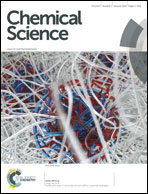New pyrido[3,4-b]pyrazine-based sensitizers for efficient and stable dye-sensitized solar cells†
Abstract
A series of new pyrido[3,4-b]pyrazine-based organic sensitizers (PP-I and APP-I–IV) containing different donors and π-spacers have been synthesized and employed in dye-sensitized solar cells (DSSCs). The absorption spectra properties of dyes are analysed by density functional theory (DFT). The calculated results in combination with the experiments suggest that the absorption characteristics and excited state features will mainly be dominated by charge transfer transitions from the highest occupied molecular orbital (HOMO) to the lowest unoccupied molecular orbital (LUMO) and to higher LUMO orbitals. Furthermore, attaching the octyloxy groups significantly extends the π-conjugation of the donor in APP-IV, which raises the HOMO energy and facilitates its oxidation. As a consequence, APP-IV exhibits the lowest HOMO–LUMO energy gap among all dyes, which, in turn, corresponds well with the red shift of the absorption spectra. Transient photovoltage and photocurrent decay experiments as well as electrochemical impedance spectroscopy indicate that the electron lifetime and charge recombination resistance are increased due to the introduction of octyloxy chains on the donor unit, resulting in the high photovoltage based on APP-IV. It was found that APP-IV based DSSCs with liquid electrolyte display the highest power conversion efficiency (PCE) of 7.12%. Importantly, a PCE of 6.20% has been achieved for APP-IV based DSSCs with ionic-liquid electrolytes and retained 97% of the initial value after continuous light soaking for 1000 h at 60 °C. This renders these pyrido[3,4-b]pyrazine-based sensitizers quite promising candidates for highly efficient and stable DSSCs.
![Graphical abstract: New pyrido[3,4-b]pyrazine-based sensitizers for efficient and stable dye-sensitized solar cells](/en/Image/Get?imageInfo.ImageType=GA&imageInfo.ImageIdentifier.ManuscriptID=C3SC51844B&imageInfo.ImageIdentifier.Year=2014)

 Please wait while we load your content...
Please wait while we load your content...